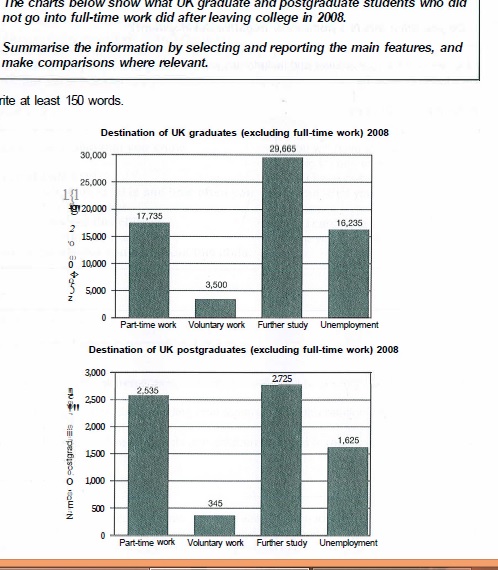wyshushu
Dec 10, 2021
Writing Feedback / Cambridge,Test 3 - the figures of four destinations of the graduates and postgraduates in England [2]
Please give review on my first attempt, thank you!!:
The bar charts display the figures of four destinations of the graduates and postgraduates in England, besides of employed with a full-time job in 2008.
Overall, the proportions of those destinations include voluntary works, further study and unemployment are similar among the two types of students, except for part-time work.
As can be seen from the charts, the number of graduates and postgraduates who purchased higher education is both the highest which reached around 95%, the figure of which is 29,665 and 2,725, respectively. Clearly, among the four types of destinations, being a volunteer was the least popular among the students in 2008. Accounting for 3500 graduates and 345 postgraduates, both are less than 20% of students.
The second similarity shows in unemployment, both figures in 2 types of students are almost a double down compared to the further study. Meanwhile, there were 17,735 graduates engaged in a part-time job, the number is slightly higher than those who were unemployed. In contrast, the number of postgraduates engaged in a part-time job is apparently higher which is 2535, amounting to five sixths of its students.
Please give review on my first attempt, thank you!!:
Destination of UK students
The bar charts display the figures of four destinations of the graduates and postgraduates in England, besides of employed with a full-time job in 2008.
Overall, the proportions of those destinations include voluntary works, further study and unemployment are similar among the two types of students, except for part-time work.
As can be seen from the charts, the number of graduates and postgraduates who purchased higher education is both the highest which reached around 95%, the figure of which is 29,665 and 2,725, respectively. Clearly, among the four types of destinations, being a volunteer was the least popular among the students in 2008. Accounting for 3500 graduates and 345 postgraduates, both are less than 20% of students.
The second similarity shows in unemployment, both figures in 2 types of students are almost a double down compared to the further study. Meanwhile, there were 17,735 graduates engaged in a part-time job, the number is slightly higher than those who were unemployed. In contrast, the number of postgraduates engaged in a part-time job is apparently higher which is 2535, amounting to five sixths of its students.

266117_1_o.jpeg
